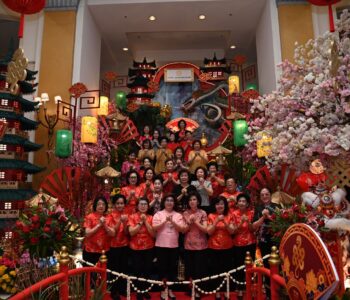Jambi, on the east coast of central Sumatra, has a textile tradition shrouded in mystery. In fact, Jambi seems to have had two textile traditions: the tradition of lembato yellow and indigo blue batiks discovered by the Dutch in the 1920s – which nearly died out by the time the Japanese invaded in 1942 – and an older, perhaps ancient tradition of morinda red cloths that all but disappeared in the mid-19th century. Nevertheless, Jambi batik is again flourishing today, thanks to the persistence of a handful of women who carried the tradition through the worst of times.

Jambi was an important trading center from at least the 7th century CE and is believed to have been the site of the Hindu-Buddhist kingdom of Melayu. The fine imported cottons and silks from China, India, Java, and the Arab world were highly valued by the royal families, while simpler cloths were exchanged for goods such as wax, resin, ivory, and incense from upstream people in the interior. By the 16th century, Dutch and English ships were also arriving at the Jambi Sultanate to trade in Indian cloth and pepper.
Although the Dutch extended their reach into Sumatra over the years, Jambi continued to resist Dutch rule until 1904. Dutch officials and collectors therefore had little opportunity to observe or collect textiles made in the region; many scholars simply concluded that Jambi did not produce its own textiles. However, research by the British scholar Fiona Kerlogue in the 1990s demonstrated that Jambi indeed had a long-standing textile tradition of its own.

Red textiles were clearly important in the adat of Jambi chiefs, and Kerlogue speculates that local production of these red cloths may have involved a variety of techniques beyond tulis batiking, including some imported from India, such as mordant block printing. The move of Jambi Sultan Taha’s court upstream in 1858 to evade the Dutch invasion seems to have coincided with the end of this industry.
At the same time, a number of stories point to the introduction of Javanese batik techniques into Jambi in 1875, when a certain Haji Mahebat moved to the region from central Java. The women of his household began making batik with local dyes and passed their skills on to several generations of Jambi women. However, by the period before the Japanese occupation, only two, possibly three women, including a woman named Zainab, were still batiking. After the war, in the 1950s and 1960s, Zainab taught a small group of girls, including her daughter Fatmah and an older girl named Asmah, how to apply wax and dye the cloth.

Ibu Asmah binti M. Aziz was the oldest in this group, and she alone continued to make batik in the years that followed. In 1975, she opened a batik workshop, which she turned over to her daughter, Ibu Azmiah bint Jancik, in 1985. Ibu Azmiah went on to win multiple awards for her batiks, and several of her collections were purchased by the Horniman Museum in Great Britain.
When the wife of the provincial governor became involved in reviving the craft of batik making beginning in 1979, the knowledge of Ibu Asmah and Ibu Azniah was critical to the revival of Jambi batik. Today, there are several batik workshops in Jambi, and batik has become an important supplementary source of income for many Jambi families. Ibu Azmiah’s children, Ibu Dhita and Pak Bagus, now run the family business. Pak Bagus, who is also a textile scholar, has collected and documented over 100 old Jambi motifs, many of which are reproduced in the workshop of Rumah Batik Azmiah.

Most Jambi batik patterns are abstract representations of flowers, seeds, and fruits. Calligraphic designs point to Arab influence, while some bird patterns resemble those in Chinese fabrics. Many designs bear a striking resemblance to the patolas of India.
For more information on the batiks of Rumah Batik Azmiah, see the company’s website: http://rumahbatikazmiah.com/ or visit their stand from June 7-11 at Gelar Batik Nusantara 2017 at the Jakarta Convention Center.
More information on the history of Jambi batik can be found in the writings of Dr. Fiona Gordon Kerlogue, including her 1997 Ph.D. dissertation, Batik Cloths from Jambi, Sumatra, which can be accessed at https://hydra.hull.ac.uk/assets/hull:8279a/content.
Text by Marianne Scholte






